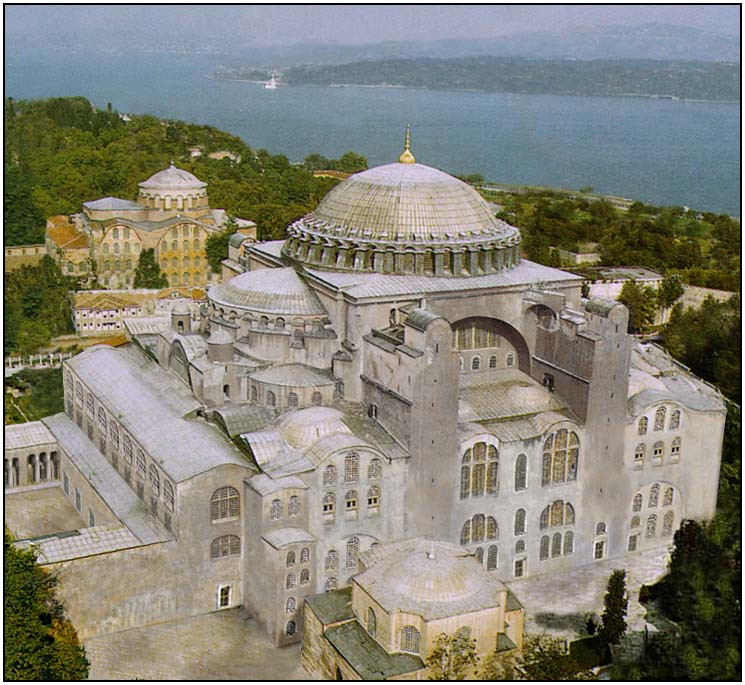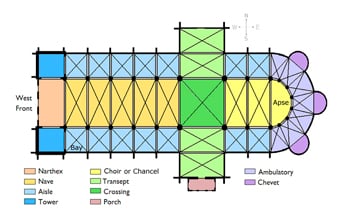Ahi Chapter 7 Quiz

.
- 1.
The capital of the Byzantine Roman Empire was ________.
- A.
Constantinople
- B.
Rome
- C.
Milan
- D.
Ravenna
Correct Answer
A. ConstantinopleExplanation
Constantinople was the capital of the Byzantine Roman Empire. It was chosen by Emperor Constantine the Great in 330 AD and served as the political, economic, and cultural center of the empire for over a thousand years. The strategic location of Constantinople, situated on the Bosporus Strait, provided protection and allowed for control over trade routes between Europe and Asia. The city was known for its impressive architecture, including the Hagia Sophia, and its rich history as a center of Byzantine power and influence. Constantinople's fall to the Ottoman Empire in 1453 marked the end of the Byzantine Empire.Rate this question:
-
- 2.
Catacomb paintings, such as those in the Catacomb of Commodilla, illustrate the two directions of Christian art: ________.
- A.
Symbolic and representational
- B.
Religious and pagan
- C.
Narrative and iconic
- D.
Overt and secretive
Correct Answer
C. Narrative and iconicExplanation
Catacomb paintings, like those found in the Catacomb of Commodilla, depict the two main aspects of Christian art: narrative and iconic. These paintings often tell stories from the Bible, conveying important religious narratives. At the same time, they also use iconic imagery, such as symbols and figures, to represent key religious concepts and ideas. Thus, the paintings in the Catacomb of Commodilla exemplify the combination of narrative storytelling and iconic symbolism that characterizes Christian art.Rate this question:
-
- 3.
Which answer below correctly labels the major parts A, B, C, D (in that order) of the central-plan church above?
- A.
Atrium, dome, apse, narthex
- B.
Atrium, apse, narthex, dome
- C.
Atrium, narthex, apse, dome
- D.
Atrium, apse, dome, narthex
Correct Answer
C. Atrium, narthex, apse, domeExplanation
The correct answer is atrium, narthex, apse, dome. The image shows a central-plan church with an atrium at the entrance, followed by a narthex, which is a vestibule or entrance hall. The apse is the semicircular or polygonal recess at the end of the church, usually where the altar is located. The dome is the rounded roof structure that covers the central space of the church.Rate this question:
-
- 4.
Christianity became the official religion of the Roman Empire at the end of the ________ century CE.
- A.
Third
- B.
Second
- C.
Fourth
- D.
First
Correct Answer
C. FourthExplanation
Christianity became the official religion of the Roman Empire at the end of the fourth century CE. This was a significant turning point in history as it marked the end of the persecution of Christians and the beginning of the Christianization of the empire. Emperor Constantine played a crucial role in this process by issuing the Edict of Milan in 313 CE, which granted religious tolerance to Christians. Over the next few decades, Christianity gained more prominence and support from subsequent emperors, culminating in the official recognition of Christianity as the state religion by Emperor Theodosius in 380 CE.Rate this question:
-
- 5.
Which future emperor led the Roman army to conquer and besiege Jerusalem in 70 CE, after it had been occupied by members of a Jewish rebeliion in 66 CE?
- A.
Constantine
- B.
Augustus
- C.
Trajan
- D.
Titus
Correct Answer
D. TitusExplanation
Titus, the future emperor, led the Roman army to conquer and besiege Jerusalem in 70 CE. This occurred after the city had been occupied by members of a Jewish rebellion in 66 CE.Rate this question:
-
- 6.
Iconoclasm refers to the ________ of works of visual art.
- A.
Legalization and creation
- B.
Prohibition and destruction
- C.
Symbolism
- D.
Dissemination
Correct Answer
B. Prohibition and destructionExplanation
Iconoclasm refers to the prohibition and destruction of works of visual art. This term is commonly used to describe the deliberate destruction or removal of religious icons or images, often due to religious or political reasons. Iconoclasm has been practiced throughout history by various cultures and religions, as a means to challenge or suppress certain beliefs or practices associated with these artworks. The destruction of these works aims to eliminate their perceived idolatrous or sacrilegious nature, and to enforce a particular religious or ideological agenda.Rate this question:
-
- 7.
Which answer below correctly labels the major parts A, B, C, D, E (in that order) of the architectural forms above?
- A.
Squinch, pendentive, oculus, dome, drum
- B.
Squinch, pendentive, drum, oculus, dome
- C.
Pendentive, squinch, drum, oculus, dome
- D.
Pendentive, squinch, dome, oculus, drum
Correct Answer
B. Squinch, pendentive, drum, oculus, domeExplanation
The correct answer is pendentive, squinch, drum, oculus, dome. This is because pendentive is a curved triangular structure that supports a dome on a square or rectangular base, squinch is a construction technique used to transition from a square or rectangular space to a circular dome, drum is the cylindrical or polygonal wall that supports the dome, oculus is a circular opening at the top of the dome, and dome is the curved roof structure that covers the space below.Rate this question:
-
- 8.
Old Saint Peter's was built on the spot where Christians believed ________ was buried.
- A.
Saint Mark
- B.
Saint John
- C.
Saint Matthew
- D.
Saint Peter
Correct Answer
D. Saint PeterExplanation
Old Saint Peter's was built on the spot where Christians believed Saint Peter was buried. This is because Saint Peter is considered one of the most important figures in Christianity and the first Pope. The belief that he was buried at this location led to the construction of the church as a place of worship and pilgrimage for Christians.Rate this question:
-
- 9.
Define Vellum.
- A.
A manuscript page
- B.
An illuminated manuscript
- C.
A bound rectangular book
- D.
Animal skin prepared for writing
Correct Answer
D. Animal skin prepared for writingExplanation
Vellum refers to animal skin that has been specially treated and prepared for writing. It was commonly used as a writing surface in the past, particularly during the medieval period. Vellum was made from the skin of various animals, such as calves, sheep, or goats, and it underwent a meticulous process of cleaning, stretching, and smoothing to create a durable and smooth surface for writing or painting. Due to its high quality and durability, vellum was often used for important documents, manuscripts, or illuminated texts.Rate this question:
-
- 10.
Many early and later christian churches (like the one above) were built on the Roman architectural model of the ________.
- A.
Forum
- B.
Basilica
- C.
Pantheon
- D.
Colonnade
Correct Answer
B. BasilicaExplanation
Many early and later Christian churches were built on the Roman architectural model of the basilica. The basilica was a type of public building in ancient Rome that served as a meeting hall or law court. It typically had a rectangular shape with a central nave and side aisles, and often featured a semicircular apse at one end. This architectural design was adopted by early Christians for their churches, providing a spacious and functional layout that could accommodate large congregations. The basilica style became prevalent in Christian architecture and influenced the development of church design throughout history.Rate this question:
-
Quiz Review Timeline +
Our quizzes are rigorously reviewed, monitored and continuously updated by our expert board to maintain accuracy, relevance, and timeliness.
-
Current Version
-
Mar 22, 2023Quiz Edited by
ProProfs Editorial Team -
Sep 30, 2011Quiz Created by
Catherine Halcomb





.jpg)


